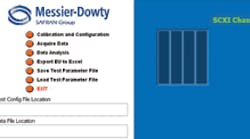Authored by: James Kondo Edited by Robert Repas Key points: • LXI instruments use hardware and software synchronization for timing accuracies into the nanosecond range. Resources: Messier-Dowty, www.messier-dowty.com Ethernet in Real Time, tinyurl.com/lhoo72 |
Each time a commercial airliner, military jet, or other aircraft touches down on a runway anywhere in the world, its pilot depends on the structural integrity and mechanical stability of the landing gear to get plane and passengers down safely. Every touchdown of a large plane could subject the main and nose gear to an instantaneous load of up to 100,000 lb. So landing-gear manufacturers need measurement tools that help characterize new gear designs and materials accurately. These tools must also generate the gear-performance data quickly, often in just a few hours or days, to permit certification of new equipment. This lets operations put planes into regular operation with passengers as soon as possible.
LXI-based instruments are high on the list of tools used over the last few years to address these challenges. LXI stands for LAN eXtensions for Instrumentation. It is an instrumentation platform that marries Ethernet-based local-area networks (LANs) to test-and-measurement equipment. The result creates small, deployable modules spread across disparate areas that report sensor readings in real time to a central controller or computer for display and analysis.
One example of an LXI-based system comes from Messier-Dowty, part of the Safran Group which designs, manufactures, and tests landing-gear systems for some of the world’s best-known manufacturers of commercial and military aircraft. The firm has a special group that acquires test data which design and system engineers need to refine landing gears. Recent test challenges for this group included characterizing the Boeing 787 Dreamliner nose landing gear and the main and nose landing gear of the Sukhoi SuperJet 100 Russian regional jet.
A battery of tests run under the LabView program help size up the performance of landing gears. These tests include gear-operation exercises, strength tests, and fatigue tests. Gear-operation routines verify the functions of the landing gear to ensure it extends and retracts properly under various air loads and atmospheric conditions. They also confirm the avionics works as designed. Strength testing places increasing stress on a gear to verify it withstands ultimate loads and to ensure it meets the maximum load specification. Fatigue tests cycle the gear through hundreds of thousands of extension-retraction cycles under various loads to ensure it holds up through a lifetime of use. Other landing gear fatigue tests simulate ground handling and extension/retraction in flight to verify the design meets the “analytical fatigue life.”
Regardless of the test procedure, the data-acquisition gear involved must handle high channel counts and sample rates. There may be as many as 300 instrumentation channels on a single landing gear each sampled at up to 5,000 samples/sec. To get measurements with enough resolution, 24-bit a/d converters are used to digitize measured values.
The test hardware must accommodate signals from such sensor as load cells, strain gages, pressure transducers, and so forth. To speed things along, the connectors and interconnects must permit quick changes to the various sensors. All of the data must be time-synchronized to make clear the relationship between various events during the course of a test.
For many tests, Messier-Dowty standardized on VTI Instruments’ (Irvine, Calif.) EX1629 48-channel high-performance strain-gage instrument. Each chassis supports up to 48 channels of data acquisition. Multiple chassis can link together in a master/slave relationship via the LXI-based external trigger bus to create larger test setups. Individual 24-bit a/d converters for each channel and a high accuracy onboard clock synchronize data to the nanosecond, boosting confidence that recorded events are precisely time-aligned.
A sampling rate of up to 25,000 samples/sec leaves a margin for future add ons. The instruments have internal and external shunt calibration that quickly lets the test engineer determine if the data from a specific channel is valid and also decide if the readings are an artifact of the measurement system or reflect the actual phenomenon being measured.
The EX1629s are qualified for use with RJ45 telecom connectors and Ethernet cables used in wiring and connecting the test systems. The RJ45s are relatively inexpensive and easy to change.
Each instrument has an onboard Web page, an important LXI-based capability, that gives quick access to basic functions. For example, fatigue tests often need six EX1629s to handle more than 250 strain gages. Changing or adding an EX1629 chassis is as simple as entering a particular instrument’s IP address into a Web browser, then entering new IP addresses as needed. The built-in Web page can also reset or reboot an instrument if there is a system hangup, then quickly go back to take readings.
The LXI-based Trigger Bus, a hardware trigger interface, provides tight timing synchronization. This, along with precise time stamping of stimulus and response events, makes for accurate testing and analysis. This is particularly critical when the data of interest spans only a few seconds of readings from hundreds of channels at thousands of samples/second. Earlier data-acquisition systems dropped sample rates as more channels were added. In addition, such systems encountered problems with channel skew. The data measurements arrived at different times, making it difficult to determine cause and effect. However, the trigger bus allows creation of scalable systems by permitting connections among as many chassis as needed. It lets all chassis acquire data at exactly the same time with exactly the same time stamp.
From an operator perspective, one of the greatest advantages of the new system is the degree to which it behaves like the old system. The instruments continue to use the familiar MDAQ-T user interface developed by Messier-Dowty to handle earlier test setups. This minimizes the need for retraining and reduces operator error as well as setup and data-reduction times. Furthermore, the instrumentation has also made it easier to continue using some of the fairly costly equipment already installed.
